A comparison of sprayer technology in ginseng
Learn about the results of a sprayer study looking at how to provide the best coverage on ginseng for the control of foliar diseases.
Introduction
Established ginseng has a dense canopy and is highly susceptible to disease. Over the lifetime of a crop, an estimated 25%-50% is lost to foliar and root disease. This is why ginseng spray programs are mostly protectant fungicide applications that require coverage of all plant surfaces (Figure 1).
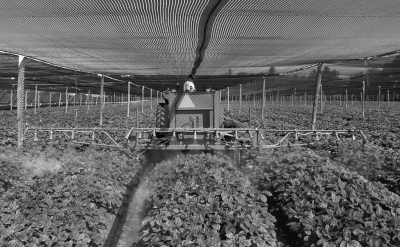
Complete coverage can be difficult to achieve given that the leaves (which are horizontal targets) and the stems and seed heads (which are vertical targets) require very different approaches. Fine droplets give suitable coverage for upper and lower leaf surfaces, but do not penetrate to the stems without air-assist and are highly prone to drift. Unless high spray volumes and slow forward speeds are employed, typical applications do not provide complete coverage. The result is that growers may need to spray more often to compensate.
A 1998 OMAFRA study established a compromise of sprayer settings and carrier volumes that would provide the best coverage. The recommendation was boom-mounted hollow-cone nozzles, drop arms mounted behind the wheels employing hollow-cone nozzles, and a carrier volume of 1,685 L/ha. The study also demonstrated that the oscillating-style sprayer equipped with a Casotti head did not provide suitable coverage. Over the last 10 years, many growers have been reducing carrier volumes in an effort to improve timeliness; others have adopted unevaluated and comparatively expensive new technologies such as ARAG microjet hollow-cone assemblies.
In 2009, OMAFRA conducted a follow-up study to confirm the 1998 findings and answer the following additional questions:
- Given their recent success in the coverage of vertical targets, will dual flat-fan nozzles with a medium droplet spray quality provide better overall coverage than the ARAG microjet hollow-cone with a medium-fine droplet spray quality? (Figure 2)
- Are the low carrier volumes used by today's growers enough to provide adequate coverage?
- How well do drop-arms fitted with hollow-cone nozzles provide coverage 360°around the stem?
Two nozzle types were compared in this study: the ARAG hollow-cone assembly and the dual-fan tip. The ARAG hollow-cone assembly features a ball valve and adjustable sheath but is essentially a hollow-cone nozzle. It does not employ air-assist or air-induction. The dual-fan tip produces two parallel 80°fans.
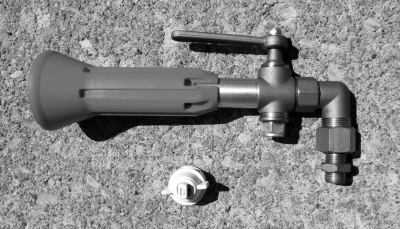
1998 Ginseng spray application trials — Methods
Table 1 summarizes the set-ups tested in the original 1998 study; three sprayer assemblies were tested using three carrier volumes. Each sprayer applied an inert red dye to a 3-year-old ginseng garden. White adhesive discs (2 cm diameter) were strategically placed on 12 plants in areas representing the common focal points of infection:
- the upper and lower surface of leaves in the outer canopy
- the upper and lower surface of leaves in the inner canopy
- below the junction of the stem and leaves (the prongs)
- at the base of the stem
Following the application, discs were collected for analysis, digitized and analyzed using image analysis software.
Table 1. 1998 sprayer assemblies.
| Pressure (k-Pa) | Speed (kph) | Carrier Volume (L/ha) | Swath (# beds) | Nozzle Type(s) | Special Feature |
|---|---|---|---|---|---|
| 1,030 | 4.8 | 561 | 2 |
| Drop arms |
| 1,030 | 4.8 | 1,222 | 2 |
| Drop arms |
| 1,030 | 4.8 | 1.684 | 2 |
| Drop arms |
| Pressure (k-Pa) | Speed (kph) | Carrier Volume (L/ha) | Swath (# beds) | Nozzle Type(s) | Special Feature |
|---|---|---|---|---|---|
| 1,030 | 4.8 | 561 | 1 |
| Air assist |
| 1,030 | 4.8 | 1,222 | 1 |
| Air assist |
| 1,030 | 4.8 | 1.684 | 1 |
| Air assist |
| Pressure (k-Pa) | Speed (kph) | Carrier Volume (L/ha) | Swath (# beds) | Nozzle Type(s) | Special Feature |
|---|---|---|---|---|---|
| 3,100 | 4.8 | 561 | 3 | N/A | None |
| 3,100 | 4.8 | 1,222 | 3 | N/A | None |
| 3,100 | 4.8 | 1,684 | 3 | N/A | None |
1998 Ginseng spray application trials — Results
The results of the 1998 study can be found in Figures 3, 4 and 5, which present a comparison of the average percent coverage for each sprayer at each volume. The results lead to the following conclusions:
- Both the air-assisted boom and the boom with drop arms performed equally. This was surprising considering air-assist opens canopies to expose hard-to-reach targets.
- The Casotti sprayer gave significantly less coverage than either the air-assisted boom or the conventional boom with drop arms at corresponding water volumes and sample locations. The Casotti sprayer is therefore not recommended for ginseng.
- At the lowest water volume on the lower leaf surface of the outer canopy, the boom with drop arms performed better than either of the other sprayers.
- Generally, increasing the water volume increased coverage, but only to a point. This is because the volume of liquid that can be retained on a surface is limited. Once wetted, the surplus drips down to the lower leaves and on to the soil.
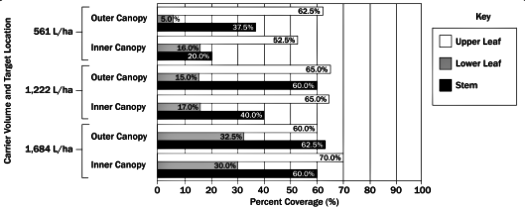
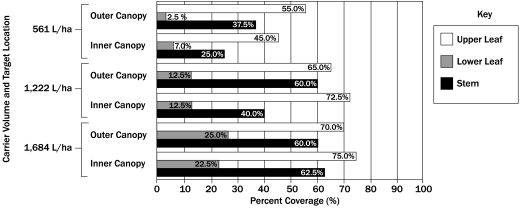
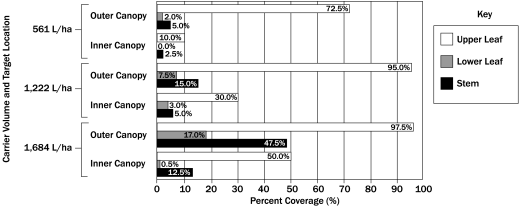
2009 Ginseng spray application trials — Methods
Trials were performed on 3-year-old ginseng on 183-cm centres under shade cloth. The garden was located near Turkey Point, Ontario. During the August 5 trials, relative humidity was an average 45%, wind was predominantly 270° (westerly) running across the beds at 4.0-5.0 kph under shade cloth and 3.0-5.5 kph outside.
The solution sprayed was clean water on a combination of vertical cylindrical and horizontal flat water-sensitive targets located randomly throughout the canopy. Five sets of targets were placed for each trial. Figure 6 illustrates the location of each target in a single set.
The study tested three sprayer set-ups and two carrier volumes Table 2). Condition 1 tested the coverage of TeeJet TJ60-8008VS twin fan nozzles at 1,000 and 1,400 L/ha. Condition 2 tested the coverage of TeeJet TJ60-8008VS twin fan nozzles at 1,000 and 1,400 L/ha with the addition of two drop-arms with two TeeJet D5-46 hollow-cone nozzles each located behind the rear wheels. They were oriented slightly upward. Condition 3 was the growers standard practice of ARAG Microjets (essentially hollow-cone nozzles) at 1,100 L/ha.
Table 2. 2009 sprayer assemblies.
| Pressure (k-Pa) | Speed (kph) | Carrier Volume (L/ha) | Swath (# beds) | Nozzle Type(s) | Special Feature |
|---|---|---|---|---|---|
| 4.1 | 4.8 | 1,000 | 2 | TJ60-8008VS | None |
| 4.1 | 3.3 | 1,400 | 2 | TJ60-8008VS | None |
| Pressure (k-Pa) | Speed (kph) | Carrier Volume (L/ha) | Swath (# beds) | Nozzle Type(s) | Special Feature |
|---|---|---|---|---|---|
| 4.1 | 4.8 | 1,000 | 2 |
| Drop arms |
| 4.1 | 3.3 | 1,400 | 2 |
| Drop arms |
| Pressure (k-Pa) | Speed (kph) | Carrier Volume (L/ha) | Swath (# beds) | Nozzle Type(s) | Special Feature |
|---|---|---|---|---|---|
| 8.9 | 4.8 | 1,100 | 3 |
| None |
2009 Ginseng spray application trials — Results
The results of the application are presented graphically in Figures 7 and 8. The following observations were made:
- Dual fan nozzles spraying medium droplets do not provide adequate inner canopy or stem coverage.
- ARAG Microject nozzles provide adequate upper surface leaf coverage both in the inner and outer canopy. They provide moderate stem coverage and very little under-leaf coverage.
- Drop arms provide excellent stem coverage and adequate under-leaf coverage.
- Generally, increasing the water volume increased coverage but only to a point. This was expected, as the volume of liquid that can be retained on a surface is limited, so, once wetted, the surplus drips down to the lower leaves and on to the soil. Carrier volumes between 1,100 L/ha and 1,400 L/ha provide adequate coverage if combined with best practices.
In the 2009 study, drop arms behind the wheels of the sprayer were able to span most, if not all, of the adjacent bed. However, for those plantings with more than three beds between the posts, it may be worth installing drop arms over each alley, not just behind the wheels. Because this may cause damage to an overgrown canopy, fit the boom with a fender (similar to those in front of the wheels) to part the canopy at each alley. Keep in mind that these results apply to a fully grown 3-yr canopy and would likely be different for younger or frost-damaged canopies.
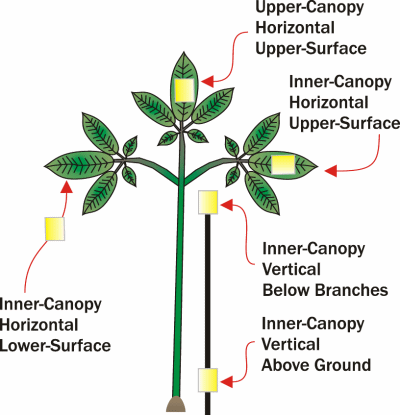
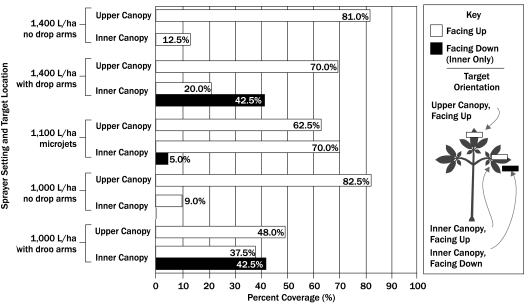
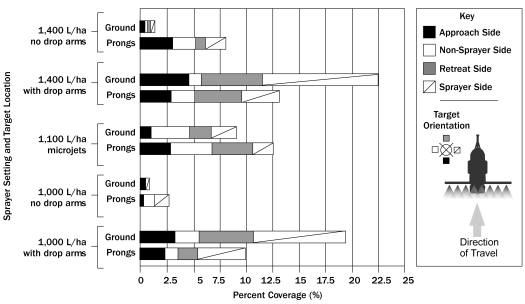
Conclusion
The importance of coverage in the control of foliar diseases cannot be understated. It is the first factor to consider when protection fails. Frequent sprayer calibration and re-orienting nozzles as the season progresses will help ensure that your sprayer performs optimally. If coverage is adequate and the choice of fungicide appropriate, but disease remains uncontrolled, consider that other factors may be responsible.
The ideal ginseng sprayer should have as many of the following features as possible. Be sure to evaluate spray coverage and penetration using water-sensitive paper:
- Use between 1,100 and 1,400 L/ha.
- Travel at a slow forward speed to allow spray to penetrate the canopy.
- Use a MEDIUM quality spray.
- Use drop nozzles behind wheels and between beds.
- Set all nozzle tips to emit hollow-cone patterns.
This Factsheet was authored by Dr. Jason Deveau, Application Technology Specialist, OMAFRA, Simcoe, and Dr. Sean Westerveld, Ginseng and Medicinal Herbs Specialist, OMAFRA, Simcoe. This Factsheet was reviewed by Helmut Spieser, Engineer, Field Crop Conditioning and Environment, OMAFRA, Ridgetown, and Jan Schooley, Crops On-Farm Food Safety Program Lead, OMAFRA, Simcoe. This Factsheet replaces the Infosheet A Comparison of Sprayer Technology in Ginseng, authored by Jan Schooley, and the Infosheet Ginseng Sprayers: Set-ups for Conventional Hydraulic Boom Sprayers with Drop Arm, authored by Paul Goodwin and Jan Schooley.
Acknowledgements
The authors would like to thank Spraying Systems Co. (TeeJet) and International Spray Jets (ARAG Group) for the donation of nozzles and equipment, and C&R Atkinson Farms Ltd. for their assistance and access to their ginseng gardens.
Footnotes
- footnote[1] Back to paragraph Mounted along boom on 30.5-cm centres
- footnote[2] Back to paragraph Mounted on boom ends, directed towards post rows
- footnote[3] Back to paragraph Two mounted per drop arm, directed away from drop arm and aimed slightly upwards